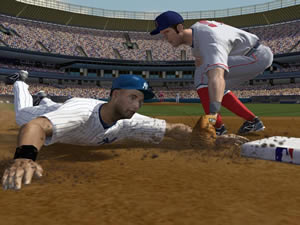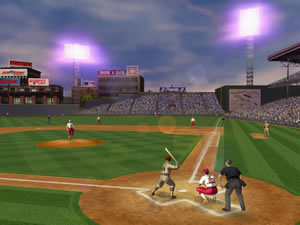Some kind of screwball.
Some gamers can’t get enough of the same old thing. You know the type – always talking about the good old days while collecting original copies of NES games and swearing that Dig Dug is the best game ever, bless their poor, ignorant souls. Chances are if you’re reading this, you want to know what’s next and what’s new, and in terms of baseball gaming, nothing is newer this year than 2K Sports’ Major League Baseball 2K5. While not nearly as smooth or intuitive as EA’s offering, it does provide the year’s most major innovation with its Baseburner feature.
If you have a runner on base, you can take direct control of him by tapping the R-stick in his direction. The camera then shifts to a close, isometric view of the base-runner and from there you can manually lead-off with the L-stick. You can also manage the batter’s behavior with the D-pad, telling him to be selective, swing, or lay off.
While Baseburner is a great idea, it isn’t seamlessly integrated. For starters, returning to the bag and proceeding to the next one are handled by two different buttons ” press one and your runner just goes, so you aren’t in complete control. This is especially apparent if you run to second from first on a fly-ball that gets caught. If you step on second, you can’t return to first because you can’t control your runner or direct him to a specific base. You can only frantically jam the return button, which uselessly returns the runner to his current base, in this case, second. Aaand, you’re out.
Still, Baseburner is a great idea and is by far the most exciting feature to be included in any of this year’s baseball titles. We can’t wait to see where it leads.
Outside of Baseburner, base-running can get pretty hectic. Taken verbatim from the instruction booklet: “To advance all runners, pull the left trigger; to retreat all runners, pull the right trigger. To retreat all runners, pull the right trigger. Pressing the left trigger will cause all runners to attempt to reach the next base.” Did we mention Major League Baseball 2K5 has the worst instruction booklet ever? It gets worse, but we won’t go there. Instead, we’ll simply say that there are a lot of ridiculous base-running glitches and inconsistencies.
This incongruous experimentation pervades the rest of Major League Baseball 2K5‘s gameplay. For example, the pitcher/batter duels now include something called the Slam Zone. If the pitcher screws up on a pitch badly enough or the batter guesses the location, the game enters the Slam Zone. Here, the batter and the pitcher both mash buttons to determine whether or not the ball turns into a home run.
If this sounds a bit obtuse, it is. Compared to the relative simplicity and clarity of MVP 2005‘s system, the Slam Zone seems a little silly. Then again, you basically saw MVP 2005‘s system in MVP 2004. With the Slam Zone, 2K Sports tries to do something really innovative and misses, but at least they try.
The batting system is a bit difficult to figure out. As the batter, you have an invisible cursor that aims your swing as well as buttons for normal and power swings. But it isn’t really clear what you’re doing when you aim the cursor. Are you aiming at that precise spot, or are you generally aiming the trajectory of the bat? I think you’re doing both, but the instruction manual doesn’t say. At any rate, the batting system in Major League Baseball 2K5 is weaker than the challenging timing-based system in EA’s game.
Fielding the ball is the same in both titles, except that Major League Baseball 2K5 uses better camera angles for a better view of the action. You make players run around on the field with the L-stick and execute lunges, dives and leaps with the R-stick. But where the animations in MVP 2005 are canned, those in Major League Baseball 2K5 are context sensitive. This means that if you’re running towards a ball and press the R-stick in its direction, you won’t leap past it. Instead, your fielder will do whatever he can to make the grab.
This doesn’t always work out, though. Sometimes your fielder will glitch and skip a couple frames of animation when you press the R-stick, and other times throwing the ball just won’t happen. We think this may be the result of the game locking up due to a log-jam of potential animations, but whatever the cause, it can be damn annoying.
 While its play mechanics are fairly unorthodox, Major League Baseball 2K5‘s selection of modes is very standard. You can play Exhibition games, In Your Face games, full Seasons, Tournaments, Home Run derbies, simulated Gamecasts, create your own scenarios with Situation mode, or dive into baseball’s managerial nuts and bolts with Franchise mode and GM Career mode.
While its play mechanics are fairly unorthodox, Major League Baseball 2K5‘s selection of modes is very standard. You can play Exhibition games, In Your Face games, full Seasons, Tournaments, Home Run derbies, simulated Gamecasts, create your own scenarios with Situation mode, or dive into baseball’s managerial nuts and bolts with Franchise mode and GM Career mode.
Before an In Your Face game starts, both sides will be presented with a list of generic challenges, usually requiring you to be the first to get X amount of hits or steal X amount of bases. If you manage to complete one of these before your rival, you get Face Points. These can then be used to disable a facet of your opponent’s game, such as sliders or power swings. In a way, Face Points represent another way to score and are a cool step in the evolution of similar challenges that have been in sports games for years.
Face Points aren’t limited to In Your Face games, although they’re a little harder to come by in normal ones. Maybe once or twice a game, you’ll be notified that you’re entering a “Home Run Inning.” If you or your opponent then knocks one out of the park, you’ll be awarded with a Face Point. This reduced role keeps the basic integrity of Major League Baseball 2K5‘s sim elements intact, while adding an extra touch of intensity here and there.
Franchise mode is extremely basic in that you hire and fire staff, trade players, and manage your AAA and AA teams in between games. You’ll want keen scouts and a good staff that can effectively recognize and foster talent ensuring a steady flow of top-notch players into your club year after year. In a barely interesting twist, player fatigue is now a major concern, so you’ll want to be sure and grant players routine days off. GM Career mode simply takes the Franchise mode and complicates it by adding the whims of an owner to your list of concerns. The owner will set long term and short term goals, and your consistency in meeting them will decide the team’s budget as well as your future within the organization.
For the most part, Major League Baseball 2K5‘s offline single-player content is thin compared to what is offered in MVP 2005. If you love to budget and micromanage, there is no question that the Owner mode of MVP 2005 is deeper and more involved than anything this game has to offer. Since the prospect of setting concession prices doesn’t necessarily make our mouths water, we were hoping that Major League Baseball 2K5 would offer something better, but it doesn’t.
Even though Franchise and GM Career offer little new in and of themselves, they are undoubtedly the most effective means of unlocking Major League Baseball 2K5‘s extra content, all of which can be accessed in the Skybox feature. Most of the stuff you unlock has been seen in earlier games, but the fact that you actually have a visual space devoted to this content remains a nice touch.
 Major League Baseball 2K5‘s online component is pleasantly deep thanks to its intuitive League system, Exhibition games, Home Run derbies and rosters. The Leagues are easy to set up, taking the forms of small tournaments or big forty game seasons, and can involve up to thirty players. Leagues aren’t new, but they’re more interesting than EA’s relatively skimpy tournament system.
Major League Baseball 2K5‘s online component is pleasantly deep thanks to its intuitive League system, Exhibition games, Home Run derbies and rosters. The Leagues are easy to set up, taking the forms of small tournaments or big forty game seasons, and can involve up to thirty players. Leagues aren’t new, but they’re more interesting than EA’s relatively skimpy tournament system.
Major League Baseball 2K5 is by far the best looking baseball game of 2005 on both the PS2 and the Xbox. While the Xbox has distinctly shorter loading times, both games look fantastic thanks to great lighting, impressive texture mapping and a generally bright, attractive presentation. The ESPN incorporation doesn’t hurt matters, either. Impressive pitching sequences are shown in a sharp replay mode, the camera angles are at once cinematic and practical, and the whole thing just looks familiar. After all, if you’re any sort of sports fan you probably watch quite a bit of ESPN.
The ESPN touch is even more crucial and effective when it comes to Major League Baseball 2K5‘s sound effects, commentary and music. Instead of the horrible, poppy garbage that drones on endlessly in MVP 2005 or the meat-headed thrash that plays during MLB 2006, Major League Baseball 2K5 sounds like an ESPN telecast. Joe Morgan and Jon Miller provide ridiculously good commentary, and so does the crowd.
Despite its better delivery, though, Major League Baseball 2K5 is not a better baseball game than MVP 2005. Its offline content is simply not as deep and its play mechanics are broadly inferior. However, it looks and sounds better, has deeper online content, and features the year’s only major innovation in a baseball game. It might not win the pennant, but it definitely makes the playoffs.
-
Excellent presentation
-
Deep online content
-
Fascinating Baseburner
-
Takes chances
-
Many of which don't work
-
Lots of weird control issues
-
Thin Franchise modes











